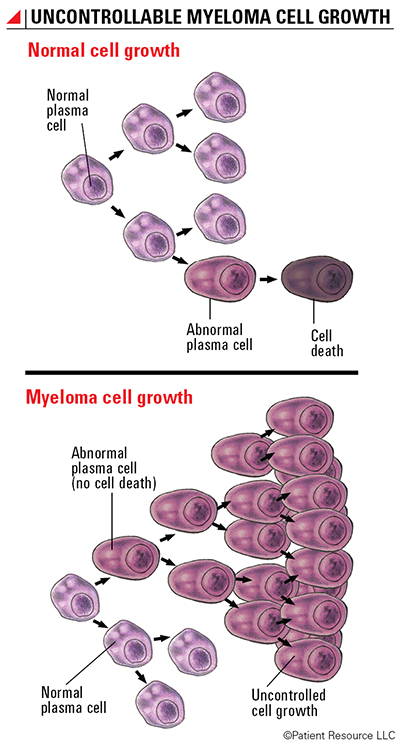Cancer Immunotherapy
Multiple Myeloma
Multiple myeloma is a hematologic (blood) cancer that develops when the blood’s plasma cells transform and grow uncontrollably.
Plasma cells are produced in the bone marrow. As a type of white blood cell that produces antibodies to fight infection when they identify a threat, they are a part of the immune system, a network of cells, organs and tissues that work together to defend your body against germs and infection.
To better understand multiple myeloma, it helps to have a general knowledge of bone marrow and blood cells.
Antibodies are proteins created from plasma cells as a reaction to foreign substances, such as bacteria, in the body.
Bone marrow is the soft, spongy center of some bones that contains immature blood stem cells, more mature blood-forming cells, fat cells and tissues that support cell growth. The immature blood stem cells, known as hematopoietic stem cells, develop into several types of blood cells, including white blood cells, red blood cells and platelets.
Lymphocytes are the primary cells in lymphoid tissue, which is a major part of the immune system. These cells develop from lymphoblasts (immature cells found in bone marrow) into mature, infection-fighting cells. Subtypes of these cells include B-lymphocytes (B-cells) and T-lymphocytes (T-cells).
Plasma cells develop from B-lymphocytes and produce antibodies to fight germs and viruses and stop infection and disease.
What is Multiple Myeloma?
When abnormal plasma cells grow out of control, they can weaken the immune system by preventing healthy plasma cells from producing antibodies. Abnormal, cancerous plasma cells are called myeloma cells, and like normal plasma cells, myeloma cells make antibodies. But myeloma cells are all the same and produce too much of the same antibody. These antibodies are called monoclonal antibody proteins, or M-proteins. M-proteins accumulate in the blood and urine and can lead to damage of the kidneys or other organs.
In people with multiple myeloma, the myeloma cells multiply uncontrollably and accumulate in bone marrow, solid parts of bone and occasionally in other organs. This accumulation of myeloma cells usually occurs in multiple areas of the bones in the body, giving the disease its name, “multiple myeloma”.
When the cells collect in bone marrow, they slow down the growth of healthy white blood cells, red blood cells and platelets. These cells collect in solid bone, causing holes called lytic lesions. The majority of people with multiple myeloma have these lesions when their disease is diagnosed.
Multiple myeloma is a type of cancer that may return. Because few people who have it are currently cured, doctors now treat it similarly to a chronic condition. Relapsed multiple myeloma occurs when the disease comes back after initial treatment. Refractory myeloma is when the disease does not respond to treatment or it stops responding to a treatment that previously worked.

Immunotherapy for Multiple Myeloma
Using immunotherapy to treat multiple myeloma is making it possible for some people to manage their disease and live longer with a better quality of life (see The Lymphatic System). Types of immunotherapy approved to treat multiple myeloma include immunomodulatory drugs and monoclonal antibodies (mAbs).
To treat multiple myeloma, immunomodulators are often combined with chemotherapy that may prevent the growth of new blood vessels that tumors need to grow. They are also often combined with a corticosteroid. Immunomodulators are most often used along with other treatments to improve initial response, stimulate the immune system and/or stop disease progression. These drugs can be effective in treating newly diagnosed multiple myeloma and relapsed or refractory disease.
Additionally, mAbs are a treatment option that may be used alone or in combination with other systemic therapies, such as a corticosteroid or an immunomodulator.
.jpg)



